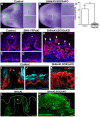SOX2 regulation by hedgehog signaling controls adult lingual epithelium homeostasis
- PMID: 29945863
- PMCID: PMC6078335
- DOI: 10.1242/dev.164889
SOX2 regulation by hedgehog signaling controls adult lingual epithelium homeostasis
Abstract
Adult tongue epithelium is continuously renewed from epithelial progenitor cells, a process that requires hedgehog (HH) signaling. In mice, pharmacological inhibition of the HH pathway causes taste bud loss within a few weeks. Previously, we demonstrated that sonic hedgehog (SHH) overexpression in lingual progenitors induces ectopic taste buds with locally increased SOX2 expression, suggesting that taste bud differentiation depends on SOX2 downstream of HH. To test this, we inhibited HH signaling in mice and observed a rapid decline in Sox2 and SOX2-GFP expression in taste epithelium. Upon conditional deletion of Sox2, differentiation of both taste and non-taste epithelial cells was blocked, and progenitor cell number increased. In contrast to basally restricted proliferation in controls, dividing cells were overabundant and spread to suprabasal epithelial layers in mutants. SOX2 loss in progenitors also led non-cell-autonomously to taste cell apoptosis, dramatically shortening taste cell lifespans. Finally, in tongues with conditional Sox2 deletion and SHH overexpression, ectopic and endogenous taste buds were not detectable; instead, progenitor hyperproliferation expanded throughout the lingual epithelium. In summary, we show that SOX2 functions downstream of HH signaling to regulate lingual epithelium homeostasis.
Keywords: Cell differentiation; Mouse; Progenitor proliferation; Smoothened antagonist; Taste bud.
© 2018. Published by The Company of Biologists Ltd.
Conflict of interest statement
Competing interestsThe authors declare no competing or financial interests.
Figures








Similar articles
-
SOX2 regulates homeostasis of taste bud cells and lingual epithelial cells in posterior tongue.PLoS One. 2020 Oct 15;15(10):e0240848. doi: 10.1371/journal.pone.0240848. eCollection 2020. PLoS One. 2020. PMID: 33057384 Free PMC article.
-
Early taste buds are from Shh+ epithelial cells of tongue primordium in distinction from mature taste bud cells which arise from surrounding tissue compartments.Biochem Biophys Res Commun. 2019 Jul 12;515(1):149-155. doi: 10.1016/j.bbrc.2019.05.132. Epub 2019 May 24. Biochem Biophys Res Commun. 2019. PMID: 31133375 Free PMC article.
-
Hedgehog Signaling Regulates Taste Organs and Oral Sensation: Distinctive Roles in the Epithelium, Stroma, and Innervation.Int J Mol Sci. 2019 Mar 16;20(6):1341. doi: 10.3390/ijms20061341. Int J Mol Sci. 2019. PMID: 30884865 Free PMC article. Review.
-
Induction of ectopic taste buds by SHH reveals the competency and plasticity of adult lingual epithelium.Development. 2014 Aug;141(15):2993-3002. doi: 10.1242/dev.107631. Epub 2014 Jul 3. Development. 2014. PMID: 24993944 Free PMC article.
-
Tongue and Taste Organ Biology and Function: Homeostasis Maintained by Hedgehog Signaling.Annu Rev Physiol. 2017 Feb 10;79:335-356. doi: 10.1146/annurev-physiol-022516-034202. Annu Rev Physiol. 2017. PMID: 28192057 Free PMC article. Review.
Cited by
-
SOX2 regulates homeostasis of taste bud cells and lingual epithelial cells in posterior tongue.PLoS One. 2020 Oct 15;15(10):e0240848. doi: 10.1371/journal.pone.0240848. eCollection 2020. PLoS One. 2020. PMID: 33057384 Free PMC article.
-
Sufu- and Spop-mediated regulation of Gli2 is essential for the control of mammalian cochlear hair cell differentiation.Proc Natl Acad Sci U S A. 2022 Oct 25;119(43):e2206571119. doi: 10.1073/pnas.2206571119. Epub 2022 Oct 17. Proc Natl Acad Sci U S A. 2022. PMID: 36252002 Free PMC article.
-
A subtype of oral, laryngeal, esophageal, and lung, squamous cell carcinoma with high levels of TrkB-T1 neurotrophin receptor mRNA.BMC Cancer. 2019 Jun 20;19(1):607. doi: 10.1186/s12885-019-5789-8. BMC Cancer. 2019. PMID: 31221127 Free PMC article.
-
The sense of taste: Development, regeneration, and dysfunction.WIREs Mech Dis. 2022 May;14(3):e1547. doi: 10.1002/wsbm.1547. Epub 2021 Nov 30. WIREs Mech Dis. 2022. PMID: 34850604 Free PMC article. Review.
-
Development of a proteomic signature associated with severe disease for patients with COVID-19 using data from 5 multicenter, randomized, controlled, and prospective studies.Sci Rep. 2023 Nov 20;13(1):20315. doi: 10.1038/s41598-023-46343-1. Sci Rep. 2023. PMID: 37985892 Free PMC article.
References
Publication types
MeSH terms
Substances
Grants and funding
LinkOut - more resources
Full Text Sources
Other Literature Sources
Molecular Biology Databases

